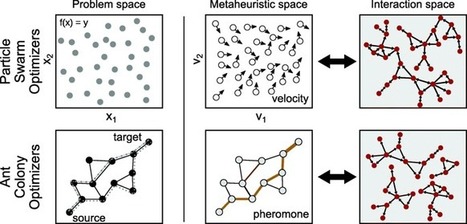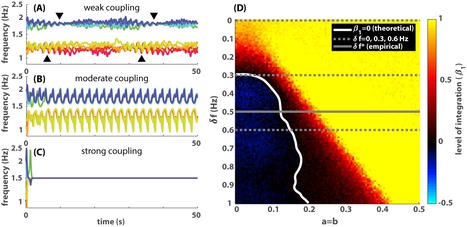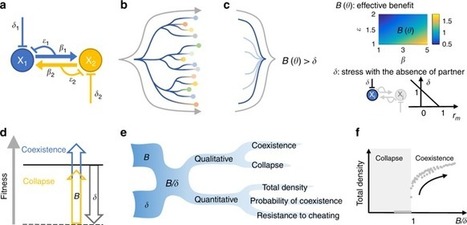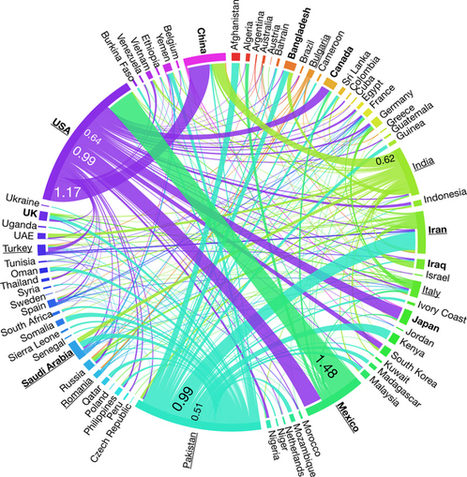 Your new post is loading...
 Your new post is loading...
MICHAŁ B. PARADOWSKI, AGNIESZKA CIERPICH–KOZIEŁ, CHIH–CHUN CHEN, JEREMI K. OCHAB MLJ Volume106, Issue4 Winter 2022 Pages 694-725 This data-driven study framed in the interactionist approach investigates the influence of social graph topology and peer interaction dynamics among foreign exchange students enrolled in an intensive German language course on second language acquisition (SLA) outcomes. Applying the algorithms and metrics of computational social network analysis (SNA), we find that (a) the best predictor of target language (TL) performance is reciprocal interactions in the language being acquired, (b) the proportion of output in the TL is a stronger predictor than input (Principle of Proportional Output), (c) there is a negative relationship between performance and interactions with same-first-language speakers, (d) a significantly underperforming English native-speaker dominated cluster is present, and (e) there are more intense interactions taking place between students of different proficiency levels. Unlike previous study abroad social network research concentrating on the microlevel of individual learners’ egocentric networks and presenting an emic view only, this study constitutes the first application of computational SNA to a complete learner network (sociogram). It provides new insights into the link between social relations and SLA with an etic perspective, showing how social network configuration and peer learner interaction are stronger predictors of TL performance than individual factors such as attitude or motivation, and offering a rigorous methodology for investigating the phenomenon. Read the full article at: onlinelibrary.wiley.com
Marcos Oliveira, Diego Pinheiro, Mariana Macedo, Carmelo Bastos-Filho & Ronaldo Menezes
Applied Network Science volume 5, Article number: 24 (2020) Swarm intelligence is the collective behavior emerging in systems with locally interacting components. Because of their self-organization capabilities, swarm-based systems show essential properties for handling real-world problems, such as robustness, scalability, and flexibility. Yet, we fail to understand why swarm-based algorithms work well, and neither can we compare the various approaches in the literature. The absence of a common framework capable of characterizing these several swarm-based algorithms, transcending their particularities, has led to a stream of publications inspired by different aspects of nature without a systematic comparison over existing approaches. Here we address this gap by introducing a network-based framework—the swarm interaction network—to examine computational swarm-based systems via the optics of the social dynamics. We investigate the structure of social interaction in four swarm-based algorithms, showing that our approach enables researchers to study distinct algorithms from a common viewpoint. We also provide an in-depth case study of the Particle Swarm Optimization, revealing that different communication schemes tune the social interaction in the swarm, controlling the swarm search mode. With the swarm interaction network, researchers can study swarm algorithms as systems, removing the algorithm particularities from the analyses while focusing on the structure of the swarm social interaction.

|
Suggested by
Mengsen Zhang
|
Coordination in living systems—from cells to people—must be understood at multiple levels of description. Analyses and modelling of empirically observed patterns of biological coordination often focus either on ensemble-level statistics in large-scale systems with many components, or on detailed dynamics in small-scale systems with few components. The two approaches have proceeded largely independent of each other. To bridge this gap between levels and scales, we have recently conducted a human experiment of mid-scale social coordination specifically designed to reveal coordination at multiple levels (ensemble, subgroups and dyads) simultaneously. Based on this experiment, the present work shows that, surprisingly, a single system of equations captures key observations at all relevant levels. It also connects empirically validated models of large- and small-scale biological coordination—the Kuramoto and extended Haken–Kelso–Bunz (HKB) models—and the hallmark phenomena that each is known to capture. For example, it exhibits both multistability and metastability observed in small-scale empirical research (via the second-order coupling and symmetry breaking in extended HKB) and the growth of biological complexity as a function of scale (via the scalability of the Kuramoto model). Only by incorporating both of these features simultaneously can we reproduce the essential coordination behaviour observed in our experiment. Connecting empirical phenomena and theoretical models of biological coordination across scales
Mengsen Zhang , Christopher Beetle , J. A. Scott Kelso and Emmanuelle Tognoli JRS Interface
Living organisms are characterized by a degree of hierarchical complexity that appears to be inaccessible to even the most complex inanimate objects. Routes and patterns of the evolution of complexity are poorly understood. We propose a general conceptual framework for emergence of complexity through competing interactions and frustrated states similar to those that yield patterns in striped glasses and cause self-organized criticality. We show that biological evolution is replete with competing interactions and frustration that, in particular, drive major transitions in evolution. The key distinction between biological and nonbiological systems seems to be the existence of long-term digital memory and phenotype-to-genotype feedback in living matter. Yuri I. Wolf, Mikhail I. Katsnelson, and Eugene V. Koonin
Via Samir
By Chengyi Tu, Joel Carr & Samir Suweis
The easy access to large data sets has allowed for leveraging methodology in network physics and complexity science to disentangle patterns and processes directly from the data, leading to key insights in the behavior of systems. Here we use country specific food production data to study binary and weighted topological properties of the bipartite country-food production matrix. This country-food production matrix can be: 1) transformed into overlap matrices which embed information regarding shared production of products among countries, and or shared countries for individual products, 2) identify subsets of countries which produce similar commodities or subsets of commodities shared by a given country allowing for visualization of correlations in large networks, and 3) used to rank country fitness (the ability to produce a diverse array of products weighted on the type of food commodities) and food specialization (quantified on the number of countries producing a specific food product weighted on their fitness). Our results show that, on average, countries with high fitness produce both low and high specializion food commodities, whereas nations with low fitness tend to produce a small basket of diverse food products, typically comprised of low specializion food commodities.
Within an ecosystem, species interact with each other in many different ways, including predation, competition, and facilitation, and this can be modelled as a network of multiple interaction types. The variety of interaction types that link species to each other has long been recognized but has rarely been synthesized for entire multi-species ecosystems. Here, we leverage a unique marine ecological network that integrates thousands of trophic and non-trophic interactions. We show that, despite its multidimensional complexity, this ecological network collapses into a small set of “functional groups,” i.e., groups of species that resemble each other in the way they interact with others in their combined trophic and non-trophic interactions. These groups are taxonomically coherent and predictable by species attributes. Moreover, dynamic simulations suggest that the way the different interaction types relate to each other allows for higher species persistence and higher total biomass than is expected by chance alone, and that this tends to promote a higher robustness to extinctions. Our results will help to guide future empirical studies and to develop a more general theory of the dynamics of complex ecological systems. Kéfi S, Miele V, Wieters EA, Navarrete SA, Berlow EL (2016) How Structured Is the Entangled Bank? The Surprisingly Simple Organization of Multiplex Ecological Networks Leads to Increased Persistence and Resilience. PLoS Biol 14(8): e1002527. http://dx.doi.org/10.1371/journal.pbio.1002527
Via Eric L Berlow
|

|
Suggested by
James Winters
|
Explanations of human technology often point to both its cumulative and combinatorial character. Using a novel computational framework, where individual agents attempt to solve problems by modifying, combining and transmitting technologies in an open-ended search space, this paper re-evaluates two prominent explanations for the cultural evolution of technology: that humans are equipped with (i) social learning mechanisms for minimizing information loss during transmission, and (ii) creative mechanisms for generating novel technologies via combinatorial innovation. Here, both information loss and combinatorial innovation are introduced as parameters in the model, and then manipulated to approximate situations where technological evolution is either more cumulative or combinatorial. Compared to existing models, which tend to marginalize the role of purposeful problem-solving, this approach allows for indefinite growth in complexity while directly simulating constraints from history and computation. The findings show that minimizing information loss is only required when the dynamics are strongly cumulative and characterised by incremental innovation. Contrary to previous findings, when agents are equipped with a capacity for combinatorial innovation, low levels of information loss are neither necessary nor sufficient for populations to solve increasingly complex problems. Instead, higher levels of information loss are advantageous for unmasking the potential for combinatorial innovation. This points to a parsimonious explanation for the cultural evolution of technology without invoking separate mechanisms of stability and creativity.
The year 2017 saw the rise and fall of the crypto-currency market, followed by high variability in the price of all crypto-currencies. In this work, we study the abrupt transition in crypto-currency residuals, which is associated with the critical transition (the phenomenon of critical slowing down) or the stochastic transition phenomena. We find that, regardless of the specific crypto-currency or rolling window size, the autocorrelation always fluctuates around a high value, while the standard deviation increases monotonically. Therefore, while the autocorrelation does not display the signals of critical slowing down, the standard deviation can be used to anticipate critical or stochastic transitions. In particular, we have detected two sudden jumps in the standard deviation, in the second quarter of 2017 and at the beginning of 2018, which could have served as the early warning signals of two major price collapses that have happened in the following periods. We finally propose a mean-field phenomenological model for the price of crypto-currency to show how the use of the standard deviation of the residuals is a better leading indicator of the collapse in price than the time-series' autocorrelation. Our findings represent a first step towards a better diagnostic of the risk of critical transition in the price and/or volume of crypto-currencies.
Via Samir
Biological complexity has impeded our ability to predict the dynamics of mutualistic interactions. Here, the authors deduce a general rule to predict outcomes of mutualistic systems and introduce an approach that permits making predictions even in the absence of knowledge of mechanistic details.
Via Samir
Recent hydrological modelling1 and Earth observations2, 3 have located and quantified alarming rates of groundwater depletion worldwide. This depletion is primarily due to water withdrawals for irrigation1, 2, 4, but its connection with the main driver of irrigation, global food consumption, has not yet been explored. Here we show that approximately eleven per cent of non-renewable groundwater use for irrigation is embedded in international food trade, of which two-thirds are exported by Pakistan, the USA and India alone. Our quantification of groundwater depletion embedded in the world’s food trade is based on a combination of global, crop-specific estimates of non-renewable groundwater abstraction and international food trade data. A vast majority of the world’s population lives in countries sourcing nearly all their staple crop imports from partners who deplete groundwater to produce these crops, highlighting risks for global food and water security. Some countries, such as the USA, Mexico, Iran and China, are particularly exposed to these risks because they both produce and import food irrigated from rapidly depleting aquifers. Our results could help to improve the sustainability of global food production and groundwater resource management by identifying priority regions and agricultural products at risk as well as the end consumers of these products.
Systems Biology is a young and rapidly evolving research field, which combines experimental techniques and mathematical modeling in order to achieve a mechanistic understanding of processes underlying the regulation and evolution of living systems. Systems Biology is often associated with an Engineering approach: The purpose is to formulate a data-rich, detailed simulation model that allows to perform numerical (‘in silico’) experiments and then draw conclusions about the biological system. While methods from Engineering may be an appropriate approach to extending the scope of biological investigations to experimentally inaccessible realms and to supporting data-rich experimental work, it may not be the best strategy in a search for design principles of biological systems and the fundamental laws underlying Biology. Physics has a long tradition of characterizing and understanding emergent collective behaviors in systems of interacting units and searching for universal laws. Therefore, it is natural that many concepts used in Systems Biology have their roots in Physics. With an emphasis on Theoretical Physics, we will here review the ‘Physics core’ of Systems Biology, show how some success stories in Systems Biology can be traced back to concepts developed in Physics, and discuss how Systems Biology can further benefit from its Theoretical Physics foundation.
|



 Your new post is loading...
Your new post is loading...

















